In
this section:
This
page:
-
Aristotle
-
Eratosthenes
-
Aristarchus
-
Hipparchus
-
Ptolemy
-
Caliph Al-Mamun
-
Ulugh Beigh
-
Mikolaj Kopernik
-
Giordano Bruno
-
Tycho Brahe
-
Johannes Kepler
-
Galileo Galilei
-
Sir Isaac Newton
|
Page
2:
-
Robert Hooke
-
John Flamsteed
-
Edmond Halley
-
Christopher Wren
-
John Gadbury
-
William Lilly
-
Jeremiah Horrocks
-
Giovanni Cassini
-
Ole Rømer
-
William Herschel
-
John Herschel
-
John Goodricke
-
John Couch Adams
-
Urbain Le Verrier
-
Lick Observatory
|
Page
3:
-
Meudon Observatory
-
Yerkes Observatory
-
Mount Wilson
-
Observatory
-
Edwin Hubble
-
George Ellery Hale
-
Royal Observatory
-
Siding Spring
-
Mauna Kea
-
Cerro Tololo Inter-American
Observatory
-
Kitt Peak
-
BTA-6
-
Mstislav Keldysh
|
Page
4:
-
Whipple Observatory
-
Wyoming Infrared Observatory
-
United Kingdom Infra-red
Telescope
-
Thirty Meter Telescope
-
Karl Jansky
-
Jodrell Bank
-
Five-hundred-meter Aperture
Spherical Telescope
-
RATAN-600
-
and more
|
This
chapter begins by stating "[The]
ancient Chinese, Egyptians and
Babylonians... did at least make
accurate observations of the skies
even if they were unable to
interpret what they saw." and Moore
does at least acknowledge that "the
famous Pyramids are astronomically
aligned" even if he is dismissive of
their knowledge, as he is of
Astrologers in the previous chapter.
"The
Egyptians timed [the annual flooding
of the Nile] by observations of the
stars, particularly Sirius, the
brightest star in the [night] sky."
|
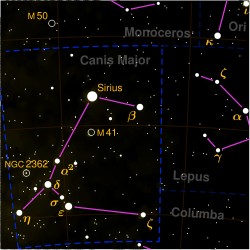 Sirius
is a binary star... It is
known colloquially as the "Dog
Star", reflecting its
prominence in its
constellation, Canis Major
(the Greater Dog). Sirius
is a binary star... It is
known colloquially as the "Dog
Star", reflecting its
prominence in its
constellation, Canis Major
(the Greater Dog).
[It wasn't
until] 1844 [that] the German
astronomer Friedrich Bessel
deduced from changes in the
proper motion of Sirius that
it had an unseen companion. On
January 31, 1862, American
telescope-maker and astronomer
Alvan Graham Clark first
observed the faint companion,
which is now called Sirius B,
or affectionately "the Pup".
This happened during testing
of an 18.5-inch (470 mm)
aperture great refractor
telescope for Dearborn
Observatory, which was one of
the largest refracting
telescope lenses in existence
at the time, and the largest
telescope in the United
States. Sirius B's sighting
was confirmed on March 8 with
smaller telescopes.
Wikipedia
 However,
as Graham Hancock reports in
his 1995 book Fingerprints of
the Gods, that it is
"suggested" in the ancient
Pyramid Texts that Sirius [Sothis]
is a "dual entity". Hancock
asks the question "How could
the scribes who wrote the
Pyramid Texts possibly have
obtained the information that
Sirius was two stars in one? However,
as Graham Hancock reports in
his 1995 book Fingerprints of
the Gods, that it is
"suggested" in the ancient
Pyramid Texts that Sirius [Sothis]
is a "dual entity". Hancock
asks the question "How could
the scribes who wrote the
Pyramid Texts possibly have
obtained the information that
Sirius was two stars in one?
He
goes on to refer to Robert
Temple's The Sirius Mystery
where the study continues into
the beliefs of the Dogon tribe
of West Africa "beliefs in
which the binary character of
Sirius was explicitly
described and in which the
correct figure of fifty years
was given for the period of
orbit of Sirius-B around
Sirius-A.
Hancock prefers to believe
that the Ancient Egyptians
gained their knowledge from an
older civilisation, whereas
Robert Temple is said to
attribute it to
extra-terrestrials.
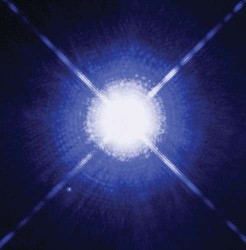 Sirius
has a radius 1.72 times that
of the sun... [The] companion
star, Sirus, B, is about as
massive as the Sun, though
much more condensed, and was
the first white dwarf star to
be discovered. [Source] Sirius
has a radius 1.72 times that
of the sun... [The] companion
star, Sirus, B, is about as
massive as the Sun, though
much more condensed, and was
the first white dwarf star to
be discovered. [Source] |
Still on the first page of our
present book, Moore says "True
astronomical science began with
Ancient Greece." Again, he is
dismissive of the extent to which
the Ancient Egyptians (and others
such as the Chinese) studied the
night sky; I accept that they seem
to have focused their findings on
and put into use as Astrology, which
science dismisses, but they
certainly knew a lot about what we
term Astronomy.
Whilst
researching the above about the
Sirius Binary system I found a news
report about another, the "Demon
Star" which the ancient Egyptians
seem to have known about. I detail
this on my
Further Reading page.
 "One man
who was well aware [that the Earth
is a globe] was Aristotle (384-322
BC)..." "One man
who was well aware [that the Earth
is a globe] was Aristotle (384-322
BC)..."
A search
on Google reveals this:
"Aristotle [also] believed the Earth
was unique and that mankind was
alone in the universe."
 Eratosthenes became chief librarian
at Alexandria, he "measured the size
of the earth" and is also said to be
the first to measure the tilt of the
Earth's axis, but I think this is
something else the Ancient Egyptians
programmed into their Pyramid. Eratosthenes became chief librarian
at Alexandria, he "measured the size
of the earth" and is also said to be
the first to measure the tilt of the
Earth's axis, but I think this is
something else the Ancient Egyptians
programmed into their Pyramid.
 Aristarchus of Samos was born in
310 BC (Moore states he died in 250
BC whereas Wikipedia has 230 BC as
the year of his death). He was an
ancient Greek astronomer and
mathematician who (it is said)
presented the first known
heliocentric model that placed the
Sun at the centre of the known
universe with the Earth revolving
around it (rather than geocentric,
that is, placing the Earth at the
centre). Aristarchus of Samos was born in
310 BC (Moore states he died in 250
BC whereas Wikipedia has 230 BC as
the year of his death). He was an
ancient Greek astronomer and
mathematician who (it is said)
presented the first known
heliocentric model that placed the
Sun at the centre of the known
universe with the Earth revolving
around it (rather than geocentric,
that is, placing the Earth at the
centre).
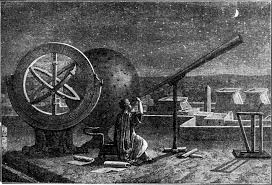 Moore
adds: "the geocentric theory held up
the progress of astronomy for well
over a thousand years." Moore
adds: "the geocentric theory held up
the progress of astronomy for well
over a thousand years."
Hipparchus of Nicaea, who
lived about 150 BC, compiled a star
catalogue [and] also [re-]discovered
the phenomenon of precession, [which
is] a slight yearly shift in the
position of the pole of the sky aka
the precession of the equinoxes.
While you might think Pythagoras was
the founder of trigonometry,
Wikipedia tells us it was Hipparchus.
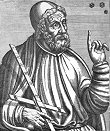 Ptolemy,
according to Wikipedia, was both an
astronomer and an astrologer. He
wrote several 'scientific treaties',
the first being the Almagest which
speaks of "the apparent motions of
the stars and planetary paths." Ptolemy,
according to Wikipedia, was both an
astronomer and an astrologer. He
wrote several 'scientific treaties',
the first being the Almagest which
speaks of "the apparent motions of
the stars and planetary paths."
One of the most influential
scientific texts of all time, it
canonized a geocentric model of the
Universe that was accepted for more
than 1200 years from its origin in
Hellenistic Alexandria, in the
medieval Byzantine and Islamic
worlds, and in Western Europe
through the Middle Ages and early
Renaissance until Copernicus.
Caliph Al-Mamun.
It is then said that "little was
added for a long time after
Ptolemy's death, and astronomy -
like other sciences - was in a state
of hibernation. Then in the eighth
century AD... Ptolemy's great book
was translated into Arabic... The
Caliph Al-Mamun founded an
observatory and also a library at
Baghdad..." [the
House of Wisdom?]. Here is a
late 15th-century copy [link]
Well educated and with a
considerable interest in
scholarship, al-Ma'mun promoted the
Translation Movement, the flowering
of learning and the sciences in
Baghdad, and the publishing of al-Khwarizmi's
book now known as "Algebra". He is
also known for supporting the
doctrine of Mu'tazilism and for
imprisoning Imam Ahmad ibn Hanbal,
the rise of religious persecution (mihna),
and for the resumption of
large-scale warfare with the
Byzantine Empire. -
Wikipedia
Astronomy
and astrology enjoyed the
special interest of princes
and the population as a whole.
The court astronomers
transcribed and further
developed the Antique Greeks’
knowledge of trigonometry and
the movement of the planets.
Parallel with this work, a
profound fascination emerged
with astrology, or at least
with its images. Innumerable
art objects from the Islamic
cultural sphere reflect this
popular enthusiasm for the
world of astrology.
The dichotomy between the
Islamic doctrine of God’s
omnipotence and the widespread
interest in the natural
sciences, philosophy, and
mysticism could not help but
lead to conflicts.
Nonetheless, what could be
called the “scientific golden
age” of the Islamic world
lasted right to the end of the
13th century. [source] |
The last great Arab astronomer
was Ulugh Beigh... In 1433 he set up
an elaborate observatory [in]
Samarkand and carried out valuable
work... his observatory had no
optical equipment - telescopes did
not come upon the scene for another
175 years - but very accurate
measurements were made with
equipment used with the naked eye.
Unfortunately Ulugh Beigh was
murdered upon the orders of his son,
whom he had banished on astrological
advice... [his observatory was also
destroyed at this time/in the same
year but rediscovered by Soviets in
1908.]

Originally the walls of the
observatory (described as a huge
sextant [link])
were lined with polished marble.
|
Whilst
reading Peter Tomkin's book
Secrets of the Great Pyramid
I could see similarities between
the Grand Gallery there, which
has been claimed/proposed by
some to have been used for
astronomical observations
(supposedly before it was
roofed over with the rest of
the pyramid), and the Samarkand observatory.
Here is a
comparative view looking up
into the former, and down into
the latter which originally
had walls lined with polished
marble (since removed, leaving
the rough sides). The Pyramid
is predominantly made out of a
combination of limestone and
granite blocks.
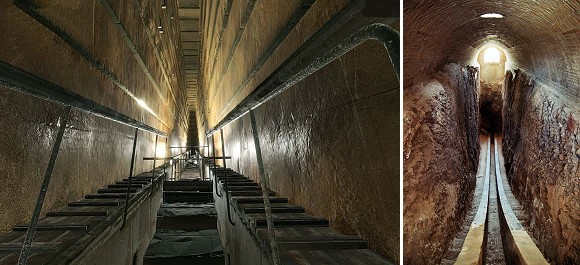 |
Mikolaj Kopernik.
Or as we know him, Copernicus, is
said to have "sparked off the great
controversy" with his heliocentric
or Sun-centred theory which he
published in his book "De Revolutionibus Orbium Coelestium"
(Concerning the Revolutions of the
Celestial Bodies) appearing in print
in 1543.
 Just
40 years later we have an
Italian Roman Catholic prelate
by the name of Egnatio/Ignazio
Danti, who was also a
mathematician, astronomer and
cosmographer who served as a
bishop (1583-1586). He was
employed to move a great
obelisk, stolen from Egypt, in
the piazza of the Vatican.
Danti’s primary assignment was
to install instruments at the
obelisk’s base that would
indicate the solstices and
equinoxes, and also the winds.
[Wikipedia]
[Book: Heilbron, J.L.: The Sun
in the Church: Cathedrals as
Solar Observatories] Just
40 years later we have an
Italian Roman Catholic prelate
by the name of Egnatio/Ignazio
Danti, who was also a
mathematician, astronomer and
cosmographer who served as a
bishop (1583-1586). He was
employed to move a great
obelisk, stolen from Egypt, in
the piazza of the Vatican.
Danti’s primary assignment was
to install instruments at the
obelisk’s base that would
indicate the solstices and
equinoxes, and also the winds.
[Wikipedia]
[Book: Heilbron, J.L.: The Sun
in the Church: Cathedrals as
Solar Observatories] |
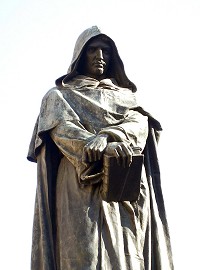 Giordano
Bruno. Copernicus was nervous
about publishing his heretical work,
and rightly so, in 1600 would be
burned at the stake in Rome "partly
because he insisted on teaching the
Copernican system instead of the
Ptolemaic." His "cosmological
theories... extended the then-novel
Copernican model. He proposed that
the stars were distant suns
surrounded by their own planets,
and... that these planets might
foster life of their own, a
cosmological position known as
cosmic pluralism." Essentially, it
was heretical to believe in E.T.s.
He also taught about "the
transmigration of the soul and
reincarnation" which also didn't go
down well. "Historian Frances Yates
argues that Bruno was deeply
influenced by Islamic astrology...
Neoplatonism, Renaissance
Hermeticism, and Genesis-like
legends surrounding the Egyptian god
Thoth." [Wikipedia]
Right: His statue in Rome at the
place of his execution [link]. Giordano
Bruno. Copernicus was nervous
about publishing his heretical work,
and rightly so, in 1600 would be
burned at the stake in Rome "partly
because he insisted on teaching the
Copernican system instead of the
Ptolemaic." His "cosmological
theories... extended the then-novel
Copernican model. He proposed that
the stars were distant suns
surrounded by their own planets,
and... that these planets might
foster life of their own, a
cosmological position known as
cosmic pluralism." Essentially, it
was heretical to believe in E.T.s.
He also taught about "the
transmigration of the soul and
reincarnation" which also didn't go
down well. "Historian Frances Yates
argues that Bruno was deeply
influenced by Islamic astrology...
Neoplatonism, Renaissance
Hermeticism, and Genesis-like
legends surrounding the Egyptian god
Thoth." [Wikipedia]
Right: His statue in Rome at the
place of his execution [link].
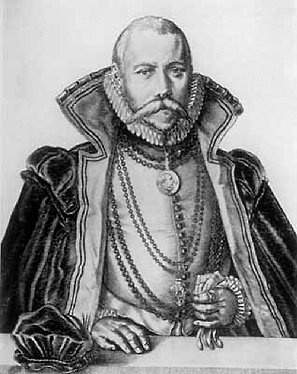 Tycho
Brahe
is referred to as "a Danish nobleman
and a “superbly accurate
[astronomical] observer – much of
the best of pre-telescopic time.”"
Wikipedia reveals a little more: Tycho
Brahe
is referred to as "a Danish nobleman
and a “superbly accurate
[astronomical] observer – much of
the best of pre-telescopic time.”"
Wikipedia reveals a little more:
Tycho was well known in his lifetime
as an astronomer, astrologer, and
alchemist. He has been described as
“the first competent mind in modern
astronomy to feel ardently the
passion for exact empirical facts”.
For some twenty years “between
1576 and 1596, [Tycho] worked away
at his observatory on the island of
Hven, in the Baltic, and he produced
a magnificent star catalogue,
together with precise positions of
Mars and the other planets as they
moved around the sky.” You can read
more about this at my blog post here
[link].
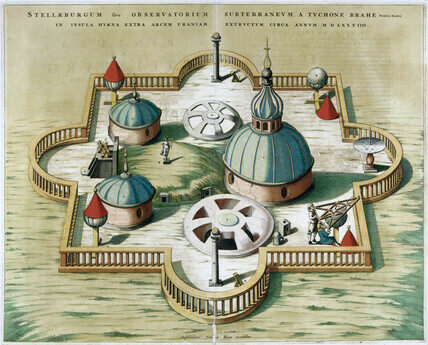
Johannes Kepler < click to read
that topic.
Galileo Galilei. The "great Italian scientist who
was the first astronomer to
make systematic use of the
telescope..." perhaps to facilitate
the making of astrological charts
for rich people. [link]
Throughout history, scientific
geniuses from Galileo to Newton have
often believed in completely
fantastical things — from astrology
to alchemy to straight-up magic. Yet
some of their bizarre ideas seemed
completely valid to them at the
time...
Galileo was also was something
like a fortune teller. He didn't
just believe in astrology: he
practiced it and taught it to
medical students.
(To
paraphrase) he made a series of
discoveries; "he saw mountains and
craters on the Moon... he recognise
what we now call the Milky Way... he
discovered four satellites attending
Jupiter and that the planet Venus
has phases, or apparent changes of
shape, similar to those of the
Moon."
However, he "made no secret of his
views, with the inevitable result
that he was called to Rome, brought
to trial by the Inquisition, and
forced to 'curse, abjure and detest'
the false theory that the Earth
moves round the Sun. He was
tortured... (and) ended his days
under house arrest..." but
(fortunately) he "was the last great
scientist to be persecuted for
'heresy' of this kind."
Sir
Isaac Newton.
Described as "the most brilliant
mathematician who has ever lived",
Newton killed off the Ptolemaic
theory and laid the foundations for
"modern-type astronomy".
However the "study of the prophecies
[was] one of his abiding interests.
For a brief time, about 1663, he
examined
judicial astrology..." - 'Never at
Rest - A Biography of Isaac Newton'
(1980) by Richard S. Westfall.
Westwall goes on to say:
 He
sought as well to plumb the mind of
God and His eternal plan for the
world and mankind as it was
presented in the biblical
prophecies... in his Arian credo,
that only the Father has
foreknowledge of future events,
indicated another dimension of
Newton's early theological studies,
the interpretation of the
prophecies. Newton's interest in the
prophecies, Daniel and the
Revelation of Saint John the Divine,
has been known since the publication
of his Observations upon the
Prophecies shortly after his death.
It has generally been assumed that
the work was a product of his old
age, as the treatise published was.
Nevertheless, references to the
prophecies filled his early
theological notebook. Already in the
1670s, he believed that the essence
of the Bible was the prophecy of
human history rather than the
revelation of truths beyond human
reason unto life eternal. Already at
that time he believed what he
asserted later about Revelation:
"There [is] no book in all the
scriptures so much recommended &
guarded by providence as this." He
put that belief into practice by
composing his first interpretation
of Revelation while engaged in his
earliest theological study. It
proved to be more than a passing
interest..." He
sought as well to plumb the mind of
God and His eternal plan for the
world and mankind as it was
presented in the biblical
prophecies... in his Arian credo,
that only the Father has
foreknowledge of future events,
indicated another dimension of
Newton's early theological studies,
the interpretation of the
prophecies. Newton's interest in the
prophecies, Daniel and the
Revelation of Saint John the Divine,
has been known since the publication
of his Observations upon the
Prophecies shortly after his death.
It has generally been assumed that
the work was a product of his old
age, as the treatise published was.
Nevertheless, references to the
prophecies filled his early
theological notebook. Already in the
1670s, he believed that the essence
of the Bible was the prophecy of
human history rather than the
revelation of truths beyond human
reason unto life eternal. Already at
that time he believed what he
asserted later about Revelation:
"There [is] no book in all the
scriptures so much recommended &
guarded by providence as this." He
put that belief into practice by
composing his first interpretation
of Revelation while engaged in his
earliest theological study. It
proved to be more than a passing
interest..."
In
his Principia he first published the
laws of universal gravitation. He
built the first reflecting
telescope, and proved that what we
call 'white' light is really a
mixture of all the colours of the
rainbow. While always remembered as
a scientist he became Master of the
Royal Mint, and played an "important
part in revising Britain's coinage."
- - - - - - - - - -
Continue to Page 2.
[Back
to Top]
|